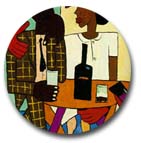
 3.
WHAT IS THE RELATIONSHIP BETWEEN
3.
WHAT IS THE RELATIONSHIP BETWEEN
THE INVITINGLY OPEN FORM OF WEB WRITING
AND OUR PROJECT OUTCOMES? Part
I
3. WHAT IS THE RELATIONSHIP BETWEEN
THE INVITINGLY OPEN FORM OF WEB WRITING
AND OUR PROJECT OUTCOMES? Part I
Cora's View:
An old creative tension is embedded in our leading "Form" question: that of form and/or/versus content. I propose that this old tension recasts itself in new (and sometimes conflicted) ways in the domain of "academic cyberspace."Consider how our choice of internet for(u)m for this panel presentation has already limited our audience. Those--perhaps many?--of our colleagues in American (and other academic) Studies, would (self-)exclude themselves because they consider "academic cyberspace" resources suspect, if not downright heretical. Our audience is further limited to those scholars, teachers, students, and others who have not only the willingness and interest to visit, but also the technological means to access our website and engage in our online discussion.
Consider, also, this departure from the traditional academic form(ula) of writing a scholarly paper to be read (even if web-posted in advance) and discussed at a professional convention. Our decision to create a website presentation freed us to speak in different ways and opened up a dialogue that has reshaped what we are saying.
|
We would
like to know . . . |
"Genre
(form) and purpose (function/content) shape each other,
develop and work together.
Genres and their conventions are not just empty forms
or containers that we simply fill up with our writing ideas
and information, genre theorists would maintain.
Rather, 'genres shape and help us recognize
our communication goals,
including why these goals exist, what and whose
purposes they serve,
and how best to achieve them' (Bawarshi
339)."
--Cora Agatucci, Cyber
Rhetoric (3): Web Genres and Purposes (2000):
URL: http://www.cocc.edu/hum299/lessons/rhet3.html
[Work Cited: Anis Bawarshi, "The
Genre Function." College English
62.3 (Jan. 2000): 335-360.]
|
We would
like to know . . . |
| So now imagine yourself a college student
used to the traditionally closed forms
that structure academic study, research, writing. You may then be able
to appreciate that opportunity to harness the multimedia capabilities of
internet technology, to learn and to express what you have learned through the
"invitingly open form" of web-authoring, would be intensely
seductive and exciting. So it was for our Humanities 299
students. Hum 299 instruction
began with hands-on practice in the operational basics of FrontPage2000,
thus unfolding the multimedia capabilities and possibilities of web-authoring technology
and communication. Our Hum 299 students were
encouraged to experiment with webpage design and layout, and quickly
became enthralled by these capabilities and possibilities. Our
students eagerly invested hours and hours outside class--conducting web
research on topics of genuine interest to them, integrating graphics and manipulating visual elements in their
webpages.
The excitement generated by students' research discoveries, experimentation and growing proficiency in web authoring was heady stuff for all of us. But, as end-of-quarter deadlines too quickly approached, one important concern began to mount centered in whether Hum 299 students would be able to finish the textual content of their websites. (10-week quarters are indeed short!) |
|
Cora concedes . . . that I could have significantly reduced student time invested in trial-and-error experimentation, in discovering and creating form, had I imposed web templates and specified genre (not to mention had I assigned topics rather than left them to student choice and discovery through exploratory research). Given the brevity of a ten or eleven-week quarter and minimal course prerequisites, perhaps I should have been more prescriptive. For example, Voices from the Gaps offers an excellent model for structuring contributions to a multicultural website:
|
| But Cora chose not to because . . . Hum 299 was an experimental special topics course, and an important part of the experiment, for me, was to see how students, given certain general parameters (i.e. principles of Cyber Rhetoric), would work out for themselves the creative tensions of form and content, and the sometimes competing demands of topic, purpose, audience, genre. |
|
Kathy's view: I do think Cora and I end up in the same place, more often than not, but the fact that we come at this key topic from different corners has led to one very specific difference in relation to this project, and it's that issue about which I'd like to provoke comment from those who view or attend our presentation. I have proposed the use of optional web templates for HUM 299| (or for the web-writing class we have also considered as an outcome of this project). Some students would choose to start with the empty canvas, but others might choose to work from a selection of simple templates (the same sort of choice Power Point provides users). It seems to me that such templates would make the work seem less overwhelming for some students, thus widening access and enrollment. An obvious template might allow for the menu to be entered as a column on the left, with space for a graphic, and space for text along the right. In my judgment, a good 60%
of academic websites end up following such a form anyway, including those produced for HUM 299. |
What do you think?
Should a course devoted to multicultural and world studies in cross-cultural diversity promote expression and communication in a diversity of (web) forms?
Join the Discussion now . . .
Continue Our Online Presentation: Form Part II . . .
|
Join the Discussion at any time! |
||
|
ASA Panel Participants |
|
We welcome
comments from all our web-visitors: Kathy Walsh kwalsh@cocc.edu Cora Agatucci cagatucci@cocc.edu |
Home
Page | Online
Presentation | Site Map
Going Online to Develop and Communicate
Student Perspectives on Multicultural and World Writers
URL of this webpage: http://www.cocc.edu/ASA/form.htm
Last updated: 06 November 2001
© Kathleen Walsh and Cora Agatucci, 2001
Central Oregon Community College
For problems regarding this web, contact: webmaster@cocc.edu